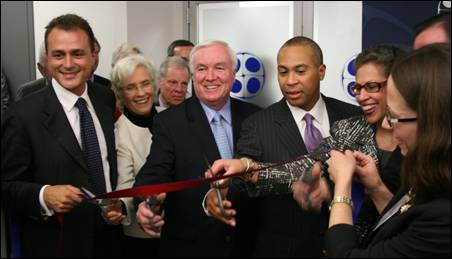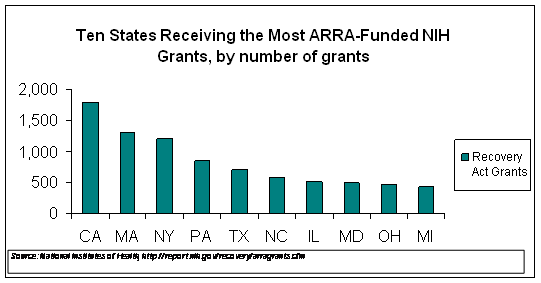

 FY2011 House 2 Budget Recommendation:
FY2011 House 2 Budget Recommendation:
Issues in Brief
Deval L. Patrick, Governor
Timothy P. Murray, Lt. Governor
The fiscal year 2011 recommendation provides up to $10 million in funding to the Massachusetts Life Sciences Center (MLSC) and assumes that $20 million in tax incentives, awarded in December, 2008, will be taken by companies. Building on the Administration and Legislature’s initiative (Chapter 130 of the Acts of 2009) to promote and advance the life sciences sector in Massachusetts, the fiscal year 2011 recommendation continues to make essential investments targeted towards job growth, business expansion and new revenues for the Commonwealth.
The Governor’s budget proposal makes additional funding available to the MLSC in fiscal year 2011 to provide research grants and accelerator loans to researchers and early-state companies. This will continue the state’s efforts to promote Massachusetts as a global leader in all stages of business development in life sciences industries, from discovery to commercialization. Finally, this funding will allow the Center to continue its efforts to expand education and workforce opportunities to Massachusetts residents, providing experience within this high-paying and growing sector.
Outside Section 39 allocates the first $10 million of any fiscal year 2010 surplus to be made available to the Massachusetts Life Sciences Investment Fund held by MLSC. Consistent with the previous two fiscal years, this funding mechanism has provided continuing state support to the Center for grants and loans, as well as supporting the operations of the agency. While the $10 million reflects an important and necessary investment in this high-growth sector, it does reflect a lower annual appropriation than was originally called for in the 2007 life sciences initiative announced by the Governor and the Legislature. The reduced amount reflects that all segments of the state budget, including key priorities of the Administration and the Legislature, have been reduced in the spirit of shared sacrifice in this fiscal downturn.

Figure 1
Governor Deval Patrick and Dr. Susan Windham-Bannister, President and CEO of the Massachusetts Life Sciences Center, attend the opening of Biocell Center's North American Headquarters, October 22, 2009.
From June 2008 through November 2009, the Center has provided $155.5 million in state-funded investments for research and academic institutions, infrastructure improvements to support innovation and business expansion, internships with private life sciences employers, and matching loans to early stage companies aiming to accelerate their business expansion. These investments were matched by $679.1 million in non-state investments, leveraging funding provided by private-sector firms and the federal government under the National Institutes of Health (NIH). As a result of these initiatives, an estimated 5,371 jobs (both permanent and construction) have been created within the state, expanding a key Massachusetts industry in the face of the national and state economic downturn. In addition, these advances will have long-standing impacts on the competitiveness of the state among the world’s leading centers for life sciences activity.
In December 2009, the Center announced for the first time the award of tax incentives to life sciences-related companies proposing to expand business operations and employment within Massachusetts over the next five years. In total, $25 million in tax incentives was granted to 28 companies which committed to expanding their total workforce by 918 jobs. Each company has similarly agreed to meet and maintain all projected job targets for no less than five years. It is anticipated that the indirect economic benefit from these jobs, commonly known as the multiplier effect, will result in substantial secondary job creation. Finally, based on the state revenue projections from the expanded income tax collections resulting from these new positions, the state will collect additional revenues equal to the amount of the tax incentives awarded within 5-to-6 years.
The Massachusetts life sciences sector has a wide-ranging spectrum of entities, including industry leaders in manufacturing, pharmaceutical and biotechnology research and development, as well as world-class academic and research institutions. There are roughly 80,000 Massachusetts residents employed in this sector, and hundreds of companies classified as life sciences-related are located in Massachusetts, generating billions in annual business activity.
Massachusetts’ competitive position in life sciences is well-illustrated through the continued success the state has had in receiving key federal funding from NIH related to discovery and commercialization in the sector.

As the chart above illustrates, Massachusetts continues to be a national leader in research and discovery in life sciences, securing the second largest funding amount in absolute dollars received in 2008 from NIH. Even more encouraging, however, is the fact that Massachusetts leads all states in annual NIH funding when adjusting for population.

Finally, some of the latest data demonstrates the state’s continuing success. The table below outlines the competitive position Massachusetts is in with respect to NIH grants funded under the American Recovery and Reinvestment Act (ARRA), second only to California in number of awards received by researchers and institutions in the state.

Prepared by Michael Esmond, Executive Office for Administration and Finance ·
www.mass.gov/budget/governor
For more information contact: contactanf@massmail.state.ma.us (617) 727-2040